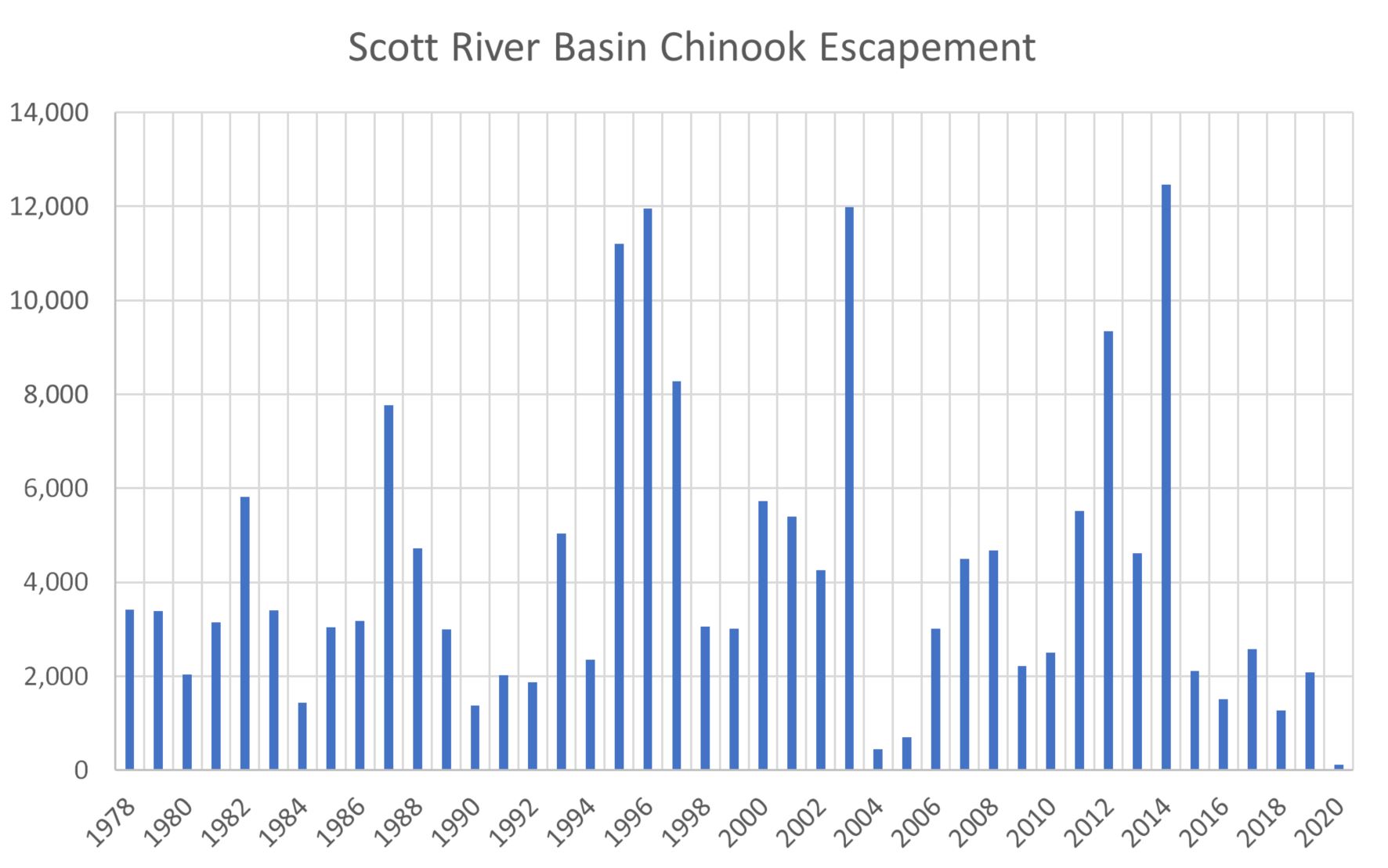The Scott River Chinook salmon, a key contributor to the overall Klamath River salmon run, are in major trouble. In a November post, I had a “mixed” prognosis for this year’s fall run. Well the numbers are now in – a record low, bleak run of 117 spawners observed (Figure 1) at the weir downstream of Fort Jones.

Figure 1. Scott River fall run salmon escapement 1978-2020. Source: CDFW unpublished data.
The poor run can be directly attributed to lack of fall river flow, a fact that I had addressed in a 2017 post. Salmon simply cannot ascend the lower Scott River into Scott Valley spawning grounds from the Klamath River because of lack of streamflow. Some may spawn in the steep canyon below the Valley (and counting weir), but poor spawning habitat and low flows in the canyon offer little solace for the salmon.
Poor fall flows (Figure 2) can be directly attributed to fall groundwater extraction and surface water diversions for hay-pasture irrigation. The State Water Board should stop crop irrigation after October 1. This irrigation practice has been getting worse over the past several decades, aided by improved well extraction and sprinkler technology and greater demand and higher revenues. Present water use permits allow irrigation into December, which ranchers have been taking advantage of to get an extra crop of hay (with the help of climate change).
Unlike 2020 (Figure 2), water use in past drought years tapered off earlier and flows increased during October (Figures 3-5). This allowed fall-run salmon access to the Valley. In contrast, recent wet and normal years see a combination of precipitation and reduced water use, which enhances fall flows (Figures 6 and 7).
In conclusion, the State Board should limit fall water irrigation in Scott Valley to save the salmon. The Sustainable Groundwater Management Act (SGMA), passed in September 2014, requires local agencies to develop Groundwater Sustainability Plans (GSP) that will assess and project future groundwater conditions, and provide management and monitoring activities. The Scott River basin is a priority basin. Siskiyou County is required to develop and submit a GSP for the Scott River basin by January 31, 2022. A preliminary plan recently developed by the advisory group suggests reducing irrigation acreage (Figure 8) to increase streamflow (Figure 9). That would help, but what salmon need is a cutoff of irrigation by October 1. An option for further augmentation is to employ unused groundwater extraction wells in the fall to add water to the river for short periods. Stored water in the tailings ponds (red area in Figure 8) could also be gravity-fed or pumped into the river at critical times.

Figure 2. Scott River flow fall 2020. Water year 2000 was a drought year.

Figure 3. Scott River flow fall 2000 and winter-spring 2001. Water year 2001 was a drought year.

Figure 4. Scott River flow fall 2013 and winter-spring 2014. Water year 2014 was a dry year.

Figure 5. Scott River flow fall 2014 and winter-spring 2015. Water year 2015 was a normal year.

Figure 6. Scott River flow fall 2016 and winter-spring 2017. Water year 2017 was a wet year.

Figure 7. Scott River flow fall 2017 and winter-spring 2018. Water year 2018 was a below normal water year.

Figure 8. Baseline (present) and preliminary action alternative for Scott Valley irrigation. Source: preliminary plan.

Figure 9. Analysis of preliminary action alternative. Source: preliminary plan.
